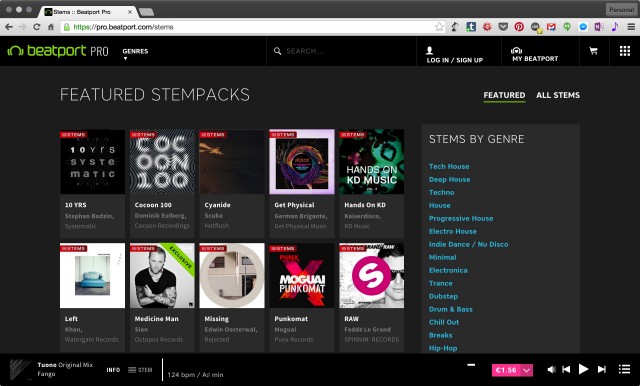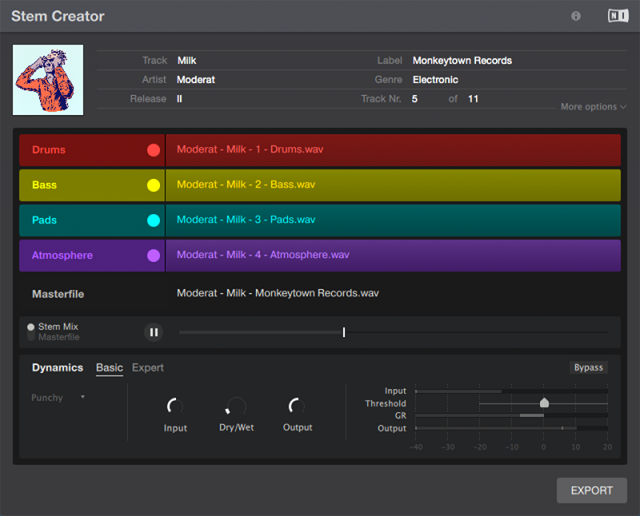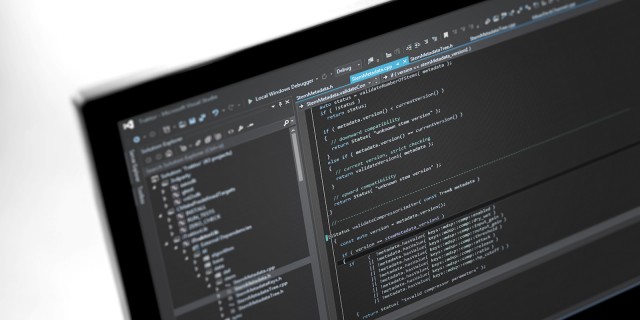Since the spring, Native Instruments has been eager to talk about Stems every chance they got. And shops and some celebrity DJs have been quick to endorse the new initiative for releasing music in multi-track, DJ-friendly formats. But today, on the occasion of the official Stems launch, you can actually get your hands on Stems – literally.
That’s because as of today, you have both usable content and DJ tools to play with it. There’s a basic but significant catalog of Stems content available, and the Traktor 2.9 software necessary to play them in a DJ set is now ready to download. With that copy of Traktor, you can map Stems control to your favorite hardware, or use out-of-the-box support from NI’s own S8 and D2, complete with visualization on those units’ displays.
Saying Stems is a revolution or that it will fundamentally change DJ performance is I think a little exaggerated. The techniques for DJing don’t really change just because you’ve divided up mixes. But that shouldn’t turn you off from the real potential here.
Stems could the direction of the tide in some key areas. First, far too many recent releases (techno, I’m looking at you) have been reduced to making DJ “tools” – stripped-down tracks composed for mixing that are basically unlistenable on their own. Ironically, I think Stems could free up producers to make songs for listening and then let DJs work out how to break them apart into a mix. Second, Stems might finally make it easier to approach DJing from a digital perspective. The reality is, most digital DJ sets you here are fairly linear mixing affairs. And I think part of the reason DJs aren’t more adventurous is, while you have tools for looping and slicing and whatnot, you might not want to do that on an entire stereo master at the same time. If you could do it on a single part, though, everything gets a bit easier – and now you can do it on material from actual tracks, not just assembling boring piles of sample packs and generic loops.
Finally, Stems could help save the download business when it’s under fire, and make a little extra cash for producers who need it to support themselves.
Here’s what’s important to know:
The music is here. No chicken and egg problem: NI is announcing chickens and eggs aplenty. Beatport, Bleep, Juno, Traxsource, whatpeopleplay, and Wasabeat (a popular Japanese store) have all begun adding Stems content to their stores, NI reports.
I started by checking out Beatport (who weirdly call them “stempacks,” which sounds like something some mad scientist will use to clone dinosaurs). The music available looks frankly fantastic – certainly for techno fans. There’s a pretty strong and unsurprising Berlin angle – you’ll find the likes of Cosmin TRG and Benjamin Damage, great new music from Lando, stems for Paula Temple’s wonderfully-brutal “Colonized” (the last one dense as hell in the normal stereo form). Stewart Walker, whom we interviewed earlier this year and who I understand had a big hand in the development of Stems, is there. But overall, there’s already a pretty good selection across genres. Current price: US$3.49 – and it’s a safe bet that’ll be the new standard.
See:
https://pro.beatport.com/stems
And for more Stems stores (some of these aren’t so obvious on the site):
Juno: www.junodownload.com/stems
Wasabeat https://www.wasabeat.com/stems
Traxsource http://traxsource.com/genre/28/stems
Whatpeopleplay https://www.whatpeopleplay.com/stems
Bleep is promised, too, though they don’t yet have a dedicated page. (As a fan of Warp and whatnot, I’ll update you when it becomes available.)
Labels and artists have gotten most of the attention, but it’s also significant that distributors are signed up. Some of them provide additional infrastructure for mastering and promotion, too. Onboard: FUGA (NL), Label Worx (UK), Paradise and Finetunes (DE), Symphonic (USA), and Bonzai (BE).
Hands-on hardware support is here. It’s no accident that the deck layouts on NI’s new S8 and D2 have four big vertical faders and a color display. You can use that to see stacked waveforms of the four stems. Accordingly, NI has an artist video showing off the DJ techniques that affords with the lovely NGHT DRPS. Here’s that film, shot at Watergate (footsteps from NI’s Berlin HQ):
If you were thinking of buying new NI gear, now is probably a good time. Oh, right, NI probably hopes Stems will give you gear lust. But if you’ve been putting of purchases, the S8 and D2 – and the F1, which has the four fader configuration minus the display – are all on sale through the end of September. I expect these will be the lowest prices we see in 2015; after that we’re into the holiday season.
The creation tools are still missing. The promise Stem Creator Tool is still listed as “coming soon,” and I’ve been told it’s nearly done. That means for now, only select labels and artists can create content; the rest of us can’t get our hands on the tools. (My understanding is, those labels have access to a non-public tool.) CDM has asked to test this tool, and we’ll share as soon as NI lets us – Stems seem like an interesting way for producers to bring even their own content into Traktor (apart from Remix Decks).
For now, you can watch this video:
And interested labels can sign up to show their intent, via email.
Developer tools are coming.. NI promises complete specifications, plus sample code and documentation. Also, they’re promising a DSP library for mastering, which is an unexpected bonus from one of the planet’s most capable DSP developers. (You’ll see a link on the creator tool page.
It’s not really a new format. It’s just MP4. “Stems” might be best described as a standard practice for sharing multi-channel audio for DJing. But it isn’t a new format: all the metadata (ID3) and the multi-channel deliver mechanism (MP4) and encoding (AAC) existed already.
So, it’s more like: “hey, let’s all agree that we’re going to meet for after-work beers every Friday at 6pm, okay?” And it’s less like, “hey, I’ve invented something new and I’m calling it ‘beer.'” That’s a good thing, though, as it’s part of why Stems is so easy to adopt.
Is it open? Is it a standard? “Open” in this case means that the format is both freely-usable (no license fees, etc.), and also documented in such a way that anyone can build their own content and tools. As a standard, “de facto standard” would be most technically accurate, but MP4 does count as a standard, with governance to match.
Four is the magic number. Now, what is important about this is, Native Instruments has standardized on four stems – that’s four stereo tracks. What you choose – maybe bassline, lead, drums, high-hats, for instance – is up to you. But by making four the “standard,” you can count on consistent mappings in software and hardware for manipulating the music.
You still have a separate stereo mix. Stems are 4+1 – four stereo tracks representing each of the four parts, and one stereo mix. That means two things: one, you still get the mastered, stereo version of the track, independent from mixing the stems together yourself. And two, if you open the Stems file in a different player (like iTunes or a CDJ), you’ll here the music as intended; you just won’t hear those stems.
Lossless or more channels are theoretically possible, but this isn’t about that. Back to MP4 – that format is a container for audio, and it already supports lossless encodings like ALAC or FLAC. It also can accommodate more than four stems. So, since NI is quick to call their format “open,” there’s nothing stopping people from building on Stems to make a system for sharing high-quality sounds – for instance, as a way of sharing projects for remixes, where you might want the lossless version.
But here’s where Stems is really an “initiative” rather than a format. Everything NI is announcing today – Traktor support, hardware control, stores with music you can buy, adoption by artists and labels – is really about the DJ-centered 4-stem content. And that’s because distributing 8-channel lossless Stems, for instance, wouldn’t really be practical for DJs. And there’s a reason for that:
Stems are big – like, on your hard drive. Open your music folder. Look at the file sizes. Now multiple each of them by a factor of five. That’s roughly what you’re talking with Stems, because you need not just one stereo file, but five of them. If NI were to go to eight tracks, you could wind up with stems you can’t control on hardware. And if they were to use a more uncompromising high quality encoding or more files, your music library would balloon in size. What they’ve done is find a compromise that gives you stems that already have five times the flexibility of music as it’s now distributed, in a format that’s reasonably high quality but doesn’t require huge file sizes.
There’s now a centralized website. Go to stems-music.com for a hub on Stems use and creation, with a mailing list for signup. And yes, that is an NI site, as —
NI are mostly steering the discussion. Open, yes; collaborative, well, not really on the tools side – not yet. Stems are really a Native Instruments project, whether their name is explicitly on it or not. It’s their tech, it works with their tools, they’re doing most of the promotion, and they’re running the show – with a whole lot of backing from artists and labels. Rival DJ vendors like Serato have been understandably quiet so far, though I imagine they might ponder Stems support depending on how content fares on Beatport and whether this forces some demand from their users.
On the other hand, remember that MIDI was a de facto standard, too, the adoption of which was largely driven by Roland (even if Dave Smith and Sequential led its design).
Pioneer seems receptive. What could change this from being “that Traktor thing that’s supposed to make you buy an S8?” Well, Pioneer support, for one. I spoke to NI CEO Daniel Haver at a public panel at the conference Tech Open Air. Daniel had just returned from Japan, and he said Pioneer was interested and supportive of the format. Remember that while Pioneer and Native Instruments are competitors, they’re somewhat friendly ones. NI’s gear is often plugged into mixers made by Pioneer, Traktor supports the CDJ as an external controller, and the two have contributed together to grow the overall DJ market. I don’t expect it to happen quickly, but if Pioneer did support Stems on hardware down the road, it’d be a huge deal.
Stems could save the download business – if you’re willing to pay more. Let’s not mince words: the music downloading business seems set to implode. When even Apple, the one company that had supported “owning” rather than “renting” music is pushing dirt-cheap streaming, when even the leading DJ store Beatport has its own streaming service, you know that’s trouble. And then you have Algoriddim’s djay app happy to let you DJ from your Spotify account, without downloading tracks.
Stems could be an escape route. They cost more, which promises more revenue for stores, labels, and artists – little wonder those folks are all so quick to sign on. And they provide content that a stream doesn’t, so there’s added reason to buy a download.
Of course, what’s yet to be seen is how many people will want Stems in the first place. NI is quick to point out that turning an EQ knob is a pretty crude way of remixing content, but DJs have been happily doing that for years. And I suspect that a lot of the would-be market for Stems are people who want to mash-up vocals from famous tracks. Whether that’s a good idea or not, that content isn’t there yet.
Stay tuned. Okay, that was … long. Fortunately, you’ll soon be able to read long-winded CDM articles in “Stems” format, where you can pick just the bit you want and remix it with content from some message forum somewhere.
Ahem.
Up next: hands-on impressions of Stems with the D2/S8 hardware, as that design clearly had this format in mind. See you.





